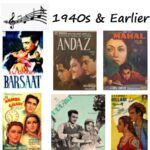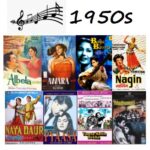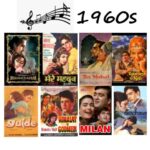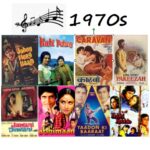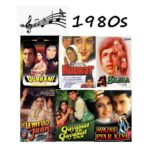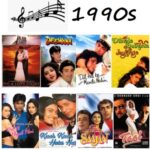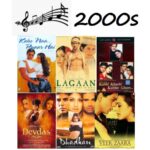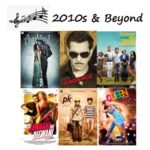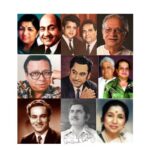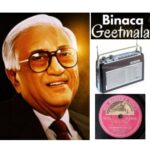Clicking on the following links or images will take you to the Hindi song collections covered in this section:
Note: Click here to go to the Blogs, Posts & Forum section on Hindi songs. For direct links to YouTube playlists of Hindi songs, please click here.
Please join me for a musical journey through the decades, as seen through my personal lens. I have compiled a list of my favorite songs for each year starting from the 1930s. I have also marked with a GEM symbol those songs I consider the “best of the best” (GEM = Genuine Masterpiece). Of course, this GEMs selection is entirely subjective, but as I have found that my tastes match quite well with a majority of people I am sure most of you will find these songs to be enjoyable as well. If you have any suggestions on additions or deletions, please share them using the Comments/Suggestions form.
I have classified the song lists by the decade as well as the year in which they were released. In addition, I have identified a set of singers, music directors, and lyricists whom I consider to be luminaries, and I have compiled lists dedicated to their respective bodies of work. Many of us fondly remember listening avidly to the weekly ranking of Hindi songs on Binaca Geetmala on Radio Ceylon, and I have a separate section on that as well.
A Brief History of Hindi Film Music
In this section, I would like to share my perspective on the different phases of the development of Hindi film music, from the 1930s to the present day. In my view, the evolution of Hindi film music can be divided into five different eras, which parallels the evolution of the Hindi film industry as a whole:
(a) Pre-1949: Studio Era. Most movies in this period were produced by a handful of studio companies (such as Bombay Talkies, Sagar Movietone and Filmistan) which employed actors, directors and music artistes on a salary under contract. Most actors were expected to sing their own songs, and playback singing had not yet become mainstream. The nasal style of singing by K.L. Saigal and others was the norm. This period also marked the emergence of Bombay as the center of virtually all Hindi film and music production.
(b) 1949-1980: Golden Age. This was truly the golden period for both Hindi films and songs, during which a vast number of composers, playback singers and lyricists emerged and quickly established themselves. Nearly every song was recorded with the singers being accompanied by an orchestra comprised of dozens of musical artistes (just like symphonies in the West). In addition, a lot of care was given to tailoring the songs to the “situation” in the film, and the “picturization” of the songs (a uniquely Indian word) became an art form which was taken to great heights by masterful directors like Vijay Anand. The distribution of Hindi music was primarily via vinyl records (78, 45 and 33 1/3 rpm), though the vast majority of Indians heard the songs on the radio (Vividh Bharti, All India Radio-Urdu Service and Radio Ceylon). The talent and creativity of the industry in these three decades were at their absolute peak, and a staggering body of musical work was created during this period which will never be surpassed.
(c) 1981-1989: Transition Period. In contrast to the preceding period, the 1980s represented the low point for Hindi film music, as many of the giants of the industry (such as Rafi, Mukesh and S.D. Burman) had passed on, retired or reached the sunset of their careers. The replacements did not come close to having the same caliber and thus their creations were passable at best. That’s why I refer to the 1980s as the “lost decade” of Hindi film music. (During this period, the Hindi film industry became better known as “Bollywood,” which until then had been more of a pejorative nickname.)
(d) 1990-2005: Revival Period. This period marked the advent of modern Hindi film music, which began to be distributed via CDs rather than cassettes. Large orchestras became a thing of the past, as synthesizers or electronic keyboards started to be used extensively, enabling asynchronous recordings of different elements of the songs. This removed the need for an entire ensemble of musicians playing together (as well as the rehearsals that came before), taking away a very important creative element from the process. Fortunately, near the end of the 1980s, fresh blood emerged in the form of new music directors such as the duos Anand-Milind and Nadeem-Shravan (and later Anu Malik and A.R. Rahman), along with talented singers like Udit Narayan, Kumar Sanu, Alka Yagnik and Anuradha Paudwal. This brought back a similar creative atmosphere to what was prevalent in the Golden Age, and many beautiful songs were created and picturized during this period.
(e) 2006-Present: Modern Bollywood. Starting in the mid-2000s, Hindi films became more of a corporate business akin to the way things are in Hollywood. Multiplexes started to sprout all over India, while the overseas market for Indian films became larger than the Indian market. With the proliferation of smart phones and the digital-music ecosystem, the primary means of distribution of Hindi film songs moved from CD’s to the internet. Thus, Hindi music followed the film business in adopting the corporate model, and these days with few exceptions most Hindi songs are virtually indistinguishable from Western songs. While there is certainly an audience for this style of music (primarily among the youth), there is no resemblance to the Hindi songs created in the latter half of the twentieth century.

